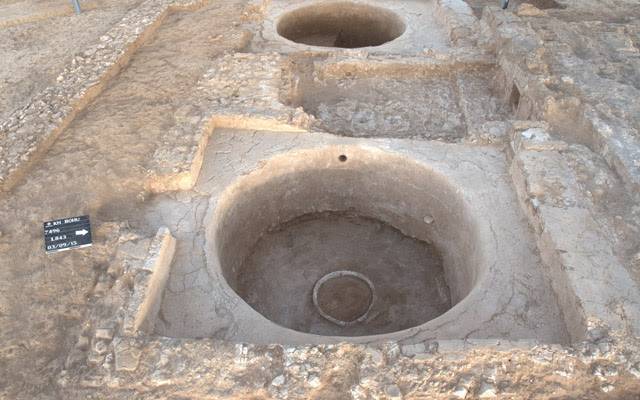Excavations in Netivot revealed the remains of a late-Byzantine-period village, including a workshop, various buildings and two wine presses.
In the course of preparations for the construction of a new residential neighborhood in the town of Netivot in the Negev, the Israel Antiquities Authority conducted a salvage excavation of the site. Youths from Netivot and nearby Ashkelon were encouraged to volunteer in the dig, along with a group of future IDF recruits currently performing a year of community service in the area.
The excavation revealed the remains of a late-Byzantine-period village dating to the 6th and 7th centuries C.E., including a workshop, various buildings and two wine presses. Fragments of marble latticework in the form of a cross and flowers indicate the existence of a public building. Other findings include tools used in daily life, such as clay cups, oil candles and seals.
Ilan Peretz, who supervised the dig for the IAA, noted that one of the most impressive finds of the excavation was a sophisticated wine press that was used to commercially produce wine.
“First, the grapes were pressed,” he said, describing the process. “Then the juice was funneled through canals to a pit where the sediment settled. From there, the wine was piped into vats lined with stone and marble, where it would ferment until it was stored in clay bottles called ‘Gaza jugs,'” hundreds of which were found on the site.
On the basis of a cross etched into seashells adorning one of the vats of the wine press, the researchers determined that the site served the Christian community living there 1400-1500 years ago.
The Modern City
Founded in 1956 as a Negev development town, Netivot is a small city in the south, located between Beersheba and Gaza. In the wake of Operation Solomon in 1991, when the IDF performed a covert military operation and brought 14,325 Jews from Ethiopia to Israel, a large number settled in Netivot.
It has been dubbed the “Varanasi of Israel,” referring to Hinduism’s holiest city, because of its strong connection to Jewish mysticism and home to one of the most revered Sephardi rabbinical dynasties.
Netivot has what is known as a steppe climate – hot and semi-arid.
In partnership between the Jewish Federation of Greater Philadelphia, Netivot was twinned with that city, the largest on the US east coast with a population of six million, including 210,000 Jews. The population of Netivot has been steadily rising for decades and now has more than 30,000 residents.
By United with Israel Staff
(With files from the Israel Antiquities Authority)

Free Ebook: 10 Best Places to Visit in Israel
The Land of Israel has provided the backdrop for some of the most important events in human history. From the Old City in Jerusalem to the Sea of Galilee, people from all over the globe visit the Holy Land each year to take in the breathtaking scenery and inspiration of Israel. Now you can experience this beauty for yourself from the comforts of home and maybe plan a trip of your own to Israel. Get the free, exclusive eBook from United with Israel: The 10 Best Places to Visit in Israel.
